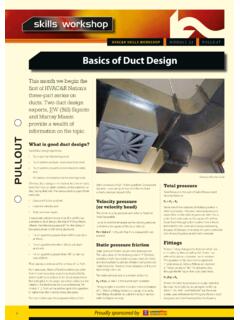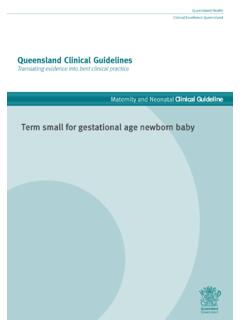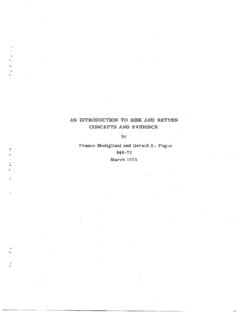Transcription of Generator Specifications for Planning, Operations Planning ...
1 Open Distribution Open Distribution Copyright 2013 North American Transmission Forum. Not for sale or commercial use. All rights reserved. Generator Specifications for Planning , Operations Planning , and Real-time Models Steady-state ratings Dynamic parameters Capability curves Generator Step-up Transformer Excitation system data Governor system data Version Disclaimer This document was created by the North American Transmission Forum (NATF) to facilitate industry work to improve power system modeling. NATF reserves the right to make changes to the information contained herein without notice. No liability is assumed for any damages arising directly or indirectly by their use or application. The information provided in this document is provided on an as is basis. North American Transmission Forum and its associated logo are trademarks of NATF.
2 Other product and brand names may be trademarks of their respective owners. Copyright 2013. All rights reserved. This legend should not be removed from the document. Generator Specifications Open Distribution 2 Table of Contents Introduction .. 3 ..3 Section 1. Nameplate Information .. 4 Inertia .. 5 Section 2. Continuous Gross Output Ratings .. 12 Section 3. Generator Reactance and Time Constants .. 6 The Generator Model .. 6 Generator Reactances .. 6 Flux patterns and saturation .. 6 Synchronous Reactance .. 7 Transient and Subtransient Reactance .. 7 Generator Time Constants .. 9 Section 4. Rotor Characteristics .. 10 Section 5. Armature Characteristics .. 11 General Information .. 11 Armature Short-Circuit Time Constants .. 11 Armature Winding Resistance .. 11 Appendix 1 symmetrical Components .. 12 Appendix 2 Transient Reactance Details.
3 15 Generator Specifications Open Distribution 3 Introduction This document explains the Generator Specifications that the Generator owner provides to the transmission planner for use in power flow, transient stability, and short-circuit studies. It accompanies the Generator Specifications workbook. Audience The audiences for this document include: 1. Generator owners who provide the information to the transmission owners. 2. Transmission owners and planners who use this information in their Planning studies. 3. Operating engineers who also use this information in their Operations Planning and real-time operating studies, including state estimators and contingency analysis . 4. Anyone looking for a simple explanation of steady-state and transient Generator Specifications . Generator Specifications Open Distribution 4 Section 1. Nameplate Information This section comprises information about the Generator s electro-mechanical Specifications that s found on its nameplate, including its pole arrangement, nameplate ratings, and per-unit base values.
4 Prime mover. Generally, the Generator s prime mover and rotor type (cylindrical versus salient-pole) are of little consequence in steady-state (power flow) analysis , but both play a major role in the Generator s transient response. Prime movers comprise high-speed steam and combustion turbines, hydro turbines, diesel engines, and wind turbines. Photovoltaic generators aren t considered as having a prime mover in the classical sense, and this document does not cover those resources. The following table summarizes the prime movers and rotor characteristics that are covered in this document. Prime Mover Typical Rotor Type Rotor Speed Inertia Constant Comments Steam Turbine Cylindrical High: 1800 or 3600 RPM High Stand-alone or back end of combined cycle Generator Combustion Turbine Cylindrical High: 1800 or 3600 RPM Fairly high Hydro Turbine Salient-pole Low: 120 RPM Highest Diesel Engine ?
5 ?? Low ??? Wind Turbine ??? Turbine: Low Generator : High (geared) Lowest Rotor type. Generally, steam and combustion turbine generators are high-speed devices that use a cylindrical rotor (Figure 1) with either two poles (most common) or four poles (typical of nuclear generators ). Hydro turbine generators are usually slow-speed devices that employ a salient pole rotor (Figure 2) with multiple poles. Rotor speed, RPM. The rotor speed in revolutions per minute, RPM. The rotor speed is: = 2(3600) Where p = the number of poles. Generator MVA rating. The rating in megavolt-amperes, MVA, stamped on the Generator nameplate. Generator voltage, kV. The nameplate voltage produced at the armature leads. Power factor, %. The power factor for maximum continuous output at which the Generator nameplate rating is calculated. Cooling method. generators typically employ air, hydrogen, or water cooling systems.
6 Hydrogen-cooled Generator are sealed to prevent hydrogen leaks, and can operate at various hydrogen pressures to increase the cooling capacity and, thus, allow the Generator to increase its MVA rating. Figure 1 - Cylindrical, two-pole Generator . Generator Specifications Open Distribution 5 Turbine nameplate rating, MWe. The megawatt rating stamped on the turbine nameplate that represents the maximum output of the turbine (expressed as electrical equivalent MW). The turbine is usually rated higher than the Generator . Short-circuit ratio. The ratio of the field current required for the rated voltage at open circuit to the field current required for the rated armature current at short circuit. V-base and S-base. The per-unit voltage and power base values provided by the manufacturer. Inertia The inertia of the Generator is the mechanical energy stored in its rotating parts the turbine, Generator , exciter1, and shaft.
7 The Generator s inertia affects how it responds mechanically (and, hence, electrically) to a disturbance on the transmission system. The total inertia of all on-line generators , and where the generators are located, determines the transient response of the entire transmission system. Moment of inertia, J (Lb-ft2). The mechanical resistance of the Generator to change its state of rotation. The moment of inertia is related to the total mass of the rotating components and their rotational speed, not the electrical rating of the Generator . Inertia constant, H (MW-seconds/MVA). The ratio of the total rotational energy stored in the rotating components divided by the Generator s nameplate MVA rating: =12 2 MVA . The inertia constant is more a function of the prime mover than the Generator , with wind generators having the lowest inertia relative to their electrical output, followed by combustion and steam turbines, with hydro turbines the (See Figure 3), The inertia constant normalizes the moment of inertia to the MVA base, which means the inertia constant should be similar among generators using the same type of prime mover regardless of size.
8 1 Assuming the exciter is driven by the same prime mover as the Generator . Exciters driven by a separate turbine do not contribute to the inertia of the turbine- Generator connected to the transmission system. 2 This should be fairly obvious given the size of the different kinds of prime movers. Figure 2 Salient, multiple-pole Generator . Figure 3 - Relative inertia constants for each prime mover type. (Values are only approximate.) Generator Specifications Open Distribution 6 Section 2. Generator Reactance and Time Constants The Generator Model Like transformers, generators consist of two electromagnetic fields that interact with each other; but unlike transformers, the fields are rotating with respect to each other and the circular shape of the rotor and armature allow the magnetic fields to spread out in multiple directions.
9 This is especially true for round-rotor generators (See Figure 6), and less so for salient pole generators (See Figure 7) due to the shape of the poles, which tends to channel the flux. Salient pole rotors often have damper windings a well to minimize the shift in the air-gap flux path when a short circuit is applied to the Generator leads. Generator Reactances Flux patterns and saturation The concepts of flux, flux saturation, and how the flux can be represented along the direct and quadrature axes of the armature and rotor are important key to understanding the Generator reactances. Flux saturation Flux saturation refers to the degree to which the rotor field or armature teeth can accommodate additional magnetic flux, which, in turn affects the value of the machine s transient and sub-transient reactances. When the Generator s flux paths are unsaturated, a sudden change in armature current (either due to a sudden load change or short circuit) is met with increased reactance due to the additional flux produced in the rotor or armature fields.
10 Conversely, if the flux path is highly saturated, changes in the armature current cannot contribute to the flux build-up, which means the Generator s reactance is reduced. Direct and Quadrature Axes To accommodate the flux path patterns, we can represent the electro-mechanical equivalents of the Generator reactances by assuming they lie in two directions: one along the direct axis of the rotor and armature windings and a second one along the quadrature axis, which is at right angles to the direct axis. (See Figure 8). Figure 4 - Flux path on a round-rotor Generator . Figure 5 - Flux path on a salient-pole Generator . Figure 6 - Generator reactance can be depicted as having two components along the direct and quadrature axes of the windings. The coils shown in this diagram serve only to represent the model of the Generator and do not have reactance values per se.




